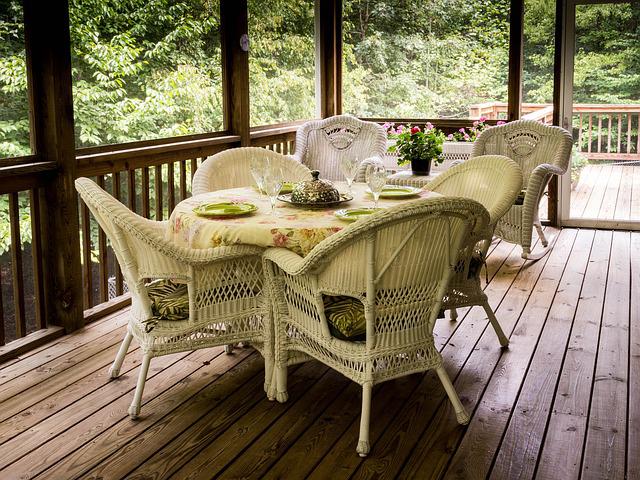It is critical to select the best material for your outdoor deck before you begin construction. If you live in a sunny and hot climate. Then you must select a decking material that will last throughout the summer. When compared to other outdoor composite decking materials, composite decking is ideal for full sun decking.
traditional Wood Decking
Traditional wood is an unsuitable material for full-sun decking for a variety of reasons. UV rays can damage the honeycomb structure of wood decking, and when exposed to the sun, the wood will naturally weather due to UV radiation. Furthermore, traditional wood decking is more likely to absorb and retain heat. However, direct sunlight causes the moisture in the wood to evaporate faster. This can then lead to structural issues, such as cracking and splitting of the wood deck. Furthermore, UV radiation can fade the color of wood decking, making full-sun wood decks more likely to fade.
If you use pressure-treated wood decking, you will need to perform more maintenance to keep it looking good. You will need to pressure wash and stain the deck on a regular basis, as well as replace cracked wood decking as soon as possible. This also implies that you will need to continue putting in money and labor after the wood deck is installed.
Decks with full sun to the south are the most weathered, followed by decks facing west. If you want to build a south-facing deck, you should think about using composite deck boards. One of the most popular decking materials available today is composite decking boards. Composite wood decking is strong and durable, has a beautiful appearance, and comes in a variety of colors. The composite decking material is also virtually maintenance-free, which saves you a significant amount of money on maintenance costs.
Full Sun Decking with Composite Decking
When exposed to the sun, all outdoor decking materials become hot. Different decking materials, however, absorb heat to varying degrees. While early composite decking was extremely temperature-sensitive, technology has advanced to the point where composite decking does not become excessively hot. Today’s composite decking is no hotter than traditional wood decking. Furthermore, composite decking cools faster in the shade than wood.
When considering composite decking for full sun areas, we examine how to select a quality composite decking material based on the three factors listed below.
cool composite decking
no discoloration due to strong UV rays
the amount of expansion and contraction due to temperature changes
We can better understand which composite decking is best suited for full sunlight with these three categories. An outdoor deck, like any other home improvement, must be visually appealing. You will be able to enjoy life more if you have an appealing deck design idea. High-quality composite decking that does not fade is more likely to retain its pristine appearance for an extended period of time.
Coolest Composite Decking
In the sun, all decks become hot, and the more sunlight there is, the hotter the deck becomes. This is due to the fact that decking is a flat surface that absorbs and reflects the heat of the sun as it is exposed to it. This is why decks are warmer where the sun shines brightly.
You need an outdoor deck that will not burn your feet no matter how hot the sun is. The amount of heat absorbed by a deck varies depending on the material. As a result, we require cool-to-the-touch composite decking to improve the comfort of our outdoor living.
Hollow Composite Decking series is a cooler composite wood decking by changing the material and giving a cooler touch compared to other brands of composite decking.
In addition, the Hollow Composite Decking series has a hollow structure. The hollow structure promotes air circulation, which helps to dissipate heat in composite decking boards. The hollow structure also reduces the weight of composite wood decking, making transporting and installing outdoor decking easier.
You can also choose a light color to further reduce the temperature of outdoor composite decking. Grey composite decking, white composite decking, and so on.
Strong UV rays will not cause it to fade
UV rays from the sun can cause severe fading of outdoor wood decking. As a result, your outdoor design becomes unappealing. As a result, it is critical to select high-quality composite deck boards that will not fade.
Fade-resistant composite decking is available from the majority of composite decking manufacturers on the market. They have added UV inhibitors to the composite decking formula to provide better UV protection. You can also choose capped composite decking, which is more environmentally friendly than uncapped composite decking.
The amount of temperature-related expansion and contraction
Thermal expansion and contraction affect almost all materials. When the sun shines brightly on the floor, outdoor decking experiences greater thermal expansion and contraction. And what does an outdoor deck’s thermal expansion mean to a homeowner? It means that if you do not allow for adequate deck spacing when building your outdoor deck. Thermal expansion may cause the outdoor deck to be squeezed and deformed.
This implies that when we select composite decking. We must select composite decking brands that are guaranteed to be of high quality. With large temperature changes, high-quality composite decking will expand and contract relatively less. When installing composite decking, however, you must still allow for adequate expansion joints according to the manufacturer’s installation instructions.



